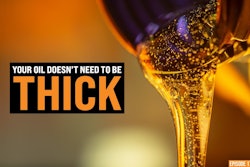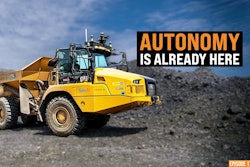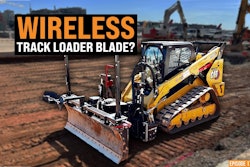The typical hard hat worn by construction workers hasn’t had a design change in over 100 years, and it only protects the top of of the head – if it stays on.
In contrast, sports head gear has undergone major innovations to provide better insulation and protect wearers from falls and being struck. Our guest on this episode of The Dirt shows that the same technology from the sports world is now available for construction workers.
Ryan Barnes, founder and CEO of Studson Inc., borrowed from snow skiing and bicycling to develop a safety helmet that not only protects the top of the head, but the front, sides and back. It also has a chin strap to keep it on in case the wearer falls.
Barnes notes that 25% of deaths in construction are caused by traumatic brain injury, and that falls from 6 feet or higher can cause a hard hat to fall off before impact. And even if the hard hat stays on, it only protects the crown.
To find out how this new type of helmet can revolutionize head safety in the construction industry, check out the latest episode of The Dirt.
Equipment World serves up weekly videos on the latest in construction equipment, work trucks and pickup trucks – everything contractors need to get their work done. Subscribe and visit us at equipmentworld.com!
In This Episode:
- 00:00 – Studson Hard Hats
- 00:31 – What Kind of Company is Studson?
- 00:55 – What’s Special About Studson Hard Hats?
- 03:05 – Interior of Studson Hard Hats
- 05:26 – Class 1 vs. Class 2 Hard Hats
- 09:41 – NFC Chip for First Responders
- 11:31 – Can You Wear a Hoodie Underneath the Hard Hat?
- 14:26 – Where Can You Buy a Studson Hard Hat?
- 14:55 – Final Thoughts
00:00:00:09 - 00:00:05:20
Bryan Furnace
Today we're here to talk about this guy, the humble hard hat, and how it is now taking a step into the 21st century along with all of our other equipment. So let's get into the meat of why this is important and why this is a good change for the industry. Joining us today is Ryan Barnes from Studson.
00:00:31:19 - 00:00:38:04
Bryan Furnace
So just at a high level, can can we start with you giving us an idea of who starts in is and what you guys do?
00:00:38:06 - 00:00:54:00
Ryan Barnes
Yeah. Studson, produces, by the neck PPE. We got into the industry primarily to develop a better industrial safety helmet, but we make all the accessories and attachments to go along with it, which are primarily above the neck as of today.
00:00:54:02 - 00:01:14:07
Bryan Furnace
So I, you know, I had it for the intro, and I'm pretty excited about that. I actually have one of these in person and and looking at it, the design and construction of this is totally different than our traditional hard hat. Can you give us an idea of what some of the improvements to this guy are over the traditional hard hat we're all used to?
00:01:14:09 - 00:01:42:12
Ryan Barnes
Yeah. So, I mean, my background. Until starting Studson, I was in the action sports industry, ski and bike. And, you know, there's lots of more advanced technology than what you had seen four years ago in the industrial market. But the traditional hard hat has a harness system like these straps here. And most of the traditional hard hats over the last 50 plus years are just type one, which means they protect you from crown or top impacts only.
00:01:42:12 - 00:02:08:01
Ryan Barnes
Okay, nothing from the front, side or rear. You know, when we launched on this journey, we were dedicated to developing a type two and something that would protect you from all angles and impacts. We looked at how snow sports and cycling helmets were developed. And there's some some more robust or innovative materials being used. We were pretty confident we were going to use, this tubular material called choroid.
00:02:08:03 - 00:02:26:03
Ryan Barnes
This is actually a piece of what we use in our helmet. You can make it in different densities and diameters to achieve whatever crumple, you know, or shock absorption impact here you're trying to mitigate against. So we integrate it in the top, front, sides and back in the helmet.
00:02:26:05 - 00:02:26:11
Bryan Furnace
And.
00:02:26:16 - 00:02:49:21
Ryan Barnes
The impact areas. And its tubular makeup creates more airflow. It's a little bit lighter than EPS, but it performs in impact about 48% more efficiently than your standard DPS foam. So getting better impact ratings is what we are after. But the ultimate goal was to make a better helmet, a safer helmet, and definitely one that was type two and with a chin strap.
00:02:49:21 - 00:03:04:13
Ryan Barnes
So those are the kind of the the two main differences between your standard hard hat is most of them are going to be type one. There are a few type two hard hats on the market, and there are some that you can purchase with a chin strap. Or you can buy a chin strap separately.
00:03:04:15 - 00:03:28:21
Bryan Furnace
So that kind of covers the construction portion. one of the things that really stuck out to me is the interior here, where you've got that traditional webbing system. This looks a lot more like a bike helmet, which in my opinion, is far more comfortable to wear over the course of a day than that webbing that's just sitting on the crown of your head and really putting that pressure point on it.
00:03:28:23 - 00:03:51:12
Ryan Barnes
Yeah, I mean that that webbing design is potentially 100 years old. You know, the hard hat was invented in 1919. The main things that have changed are the materials of this show. They went from leather dipped to alumina, to plastics and then carbon fibers and fiber, metal, Kevlar material. So, not much has changed with the design of the interior with that four-point strap system.
00:03:51:14 - 00:04:16:17
Ryan Barnes
And, you know, if you look at other industries, whether it's NFL, whether it's hockey, lacrosse, ski, bike, most helmets are designed with some type of shock absorbing material that's surrounding the majority of your head, you know, even equestrian. And then depending on those, you know, what sports those are and what inherent risks there are, there might be lower coverage in the back or lower coverage on the sides depending on.
00:04:16:17 - 00:04:41:11
Ryan Barnes
But you know, you're you're you're trying to optimize design fit and function so that it's really comfortable and useful in the application you're using, but also has the coverage and protection that's going to keep you safe or potentially mitigate from a potential traumatic brain injury or concussion in the types of fall struck by that you might come across in the construction industry.
00:04:41:13 - 00:04:59:23
Bryan Furnace
So one of the things I'm most excited about is the fact that we no longer have this giant echo chamber in here. So when when my buddy comes over and claps me on top of the hardhat, it doesn't bust my eardrums out, which is the common prank in the industry. The acoustics seem to be significantly better with this design.
00:05:00:01 - 00:05:22:02
Ryan Barnes
That's true. I mean, EPS foam is an insulator, so it's definitely going to dampen, you also because you don't have a lot of open space, you know, you're not going to have that echo effect. It's going to have a dampening effect if someone slaps you on the top of the head, or the same as if you got hit by, you know, a spud wrench or a hammer.
00:05:22:04 - 00:05:25:04
Ryan Barnes
or if you took a rail, you know, solid impact.
00:05:25:10 - 00:05:37:18
Bryan Furnace
Yeah. So you've kind of briefly talked about the class one versus class two hard hats. why worry about moving to a class two? Why is class one not sufficient?
00:07:29:14 - 00:07:55:21
Ryan Barnes
Well, because we know, you know, the current stats are that about 25% of construction related deaths come from traumatic brain injuries, and the majority of those are from trip slips and falls. So we also know that in the majority of those cases, during a trip slip or fall, and typically they're six feet or less, that momentum makes the hard hat fall off.
00:07:55:23 - 00:08:18:02
Ryan Barnes
You can put a chinstrap on it, and you should. We don't sell any helmets without a chin strap because that's what's going to keep it secure. They do have, you know, in most safety helmet cases, they have a bit more robust fit system to adhere. You know better to your head. And you might notice that in trying our helmet on, you can adjust it front and back.
00:08:18:04 - 00:08:42:17
Ryan Barnes
you can get the chin strap adjusted so that it's not choking you and it's sitting properly so that it's comfortable to wear. but with a type one, you're only getting that protection from potential falling objects. So if you do fall down and hit your head on the side, there is nothing there to absorb the energy. you know, in a traditional harness system, you're just going to your head's going to, you know, hit the side of a plastic shell.
00:08:42:19 - 00:09:20:11
Ryan Barnes
So having some type of material surrounding your head. 360 in this day and age, knowing what the data points tell us, we believe is the way to go. Now, I did say that EPS is an insulator, so it does trap more heat than what you're going to have in your traditional hard hat. But by using the choroid in the design, the way we designed the interior and you mentioned similar to a bike helmet, I mean, we we designed it almost identically to a bike helmet where you have these channels for airflow, so that you don't just have a big block of foam sitting on your head, you actually have just a few ridges
00:09:20:11 - 00:09:27:10
Ryan Barnes
sitting on your head. And so that hot air at least has a way to dissipate out the vents if you're using a class C version.
00:09:27:12 - 00:09:45:12
Bryan Furnace
I was just about to say in case people didn't see it. There are vents along each side of the hard hat so that heat is able to dissipate, versus a traditional hard hat. You're sitting with a greenhouse on your head. It's it has nowhere to go. So one of the cooler things of this helmet, can you talk about this emblem right here?
00:09:45:12 - 00:09:54:13
Bryan Furnace
This one, this one I thought was pretty awesome and really showcases how we're bringing something as simple as the hard hat into the 21st century.
00:09:54:15 - 00:10:27:06
Ryan Barnes
Yeah, that that Wi-Fi symbol, you know, tells the hopefully first responder that there's medical information there. So it's there's an NFC chip near field communication chip stored between the show on the liner. And if the user has built a profile file, they have to download the app. There's a QR code on the hang tag, but if they download the app and set up their profile, they can actually scroll through and pick what stats and helmet they've purchased or been given by their safety manager, and they can select it.
00:10:27:07 - 00:10:58:15
Ryan Barnes
It'll essentially timestamp the date of when that helmet went into into use. and then they can upload whatever emergency medical information they are comfortable with. It's typically allergies, whether you're diabetic, you might have a pacemaker. You might want people that know that you are a donor and then emergency contact info. So if you're unconscious and somebody gets to you, a first responder can scan it with any Android or iOS device.
00:10:58:17 - 00:11:10:11
Ryan Barnes
And assuming they don't have the app, it'll just send them a generic text format with all that information, and they could call your wife immediately and say, hey, we're rushing them to the hospital, yada, yada, yada.
00:11:10:13 - 00:11:30:06
Bryan Furnace
That's one of those things that you don't ever really think about until you're in that situation. And, and I found myself in that situation one time where I had a coworker that was incapacitated. And do I go digging through his pockets to call family? How do we figure out who we're supposed to call? So to have that sort of technology just right here in the hard hat, quick scan, away you go.
00:11:30:07 - 00:11:48:23
Bryan Furnace
That's awesome. My final question for you is, I'm in Michigan. Cold climate. And traditionally, what we do is we crank open the strap on our hard hat, we throw our hoodie up, and then we throw the hard hat right over top of it. With such a tight-fitting hard hat. That doesn't seem to be the case with this one.
00:11:48:23 - 00:11:52:01
Bryan Furnace
What do you have to offer for colder climates?
00:11:52:03 - 00:12:23:19
Ryan Barnes
Yeah, so good question. So one thing to note is that, you know, most of these climbing style helmets, are sleeker. they're lower profile, lower ride height. And they are designed that way. Right. So, because you're getting away from the harness and having to have a certain amount of air gap between the show, their lower profile and they have sleeker fit systems and so it makes it difficult to put something as thick and punchy as a beanie and stuff it under there.
00:12:23:19 - 00:12:46:22
Ryan Barnes
But the most important part of that is the helmets aren't tested that way. You know, the helmets are tested on a head form with nothing underneath it. We as manufacturers can't validate that it's going to perform the way that it's supposed to. And we've all seen it, right. The hard hat, whether it's a hard hat or a helmet, if it's on top of a beanie, it's probably not placed properly.
00:12:47:02 - 00:13:12:07
Ryan Barnes
It's sitting high, it's sitting back on the head. And in the case of, you know, the right type of trajectory and fall, it might not provide the protection it's designed to do. So OSHA actually put out, a guidance years ago that any type of, beanie or anything you wear under the, the hard hat should be, approved by the manufacturer.
00:13:12:07 - 00:13:34:13
Ryan Barnes
So because of that, we designed a fleece helmet liner. and we designed it to cover the ears. Come down and cover the ears, because really, in the cold weather environment, you know, these helmets, don't you know they have chin straps, but they don't have year covers built into them? maybe that's something for the future and that you'll see down the road.
00:13:34:19 - 00:14:06:21
Ryan Barnes
But we designed a fleece helmet liner that fits most heads and that fits properly underneath the helmet. I thought it was natural to also mention that we, you know, there's a lot of hot weather environments, whether it could be year-round, two, like in Texas and Florida in the south. So we did design some cooling accessories that not only cool to up to 30 degrees below your body temp when activated with water, but this one has a neck shade to hang over your neck.
00:14:06:23 - 00:14:13:17
Ryan Barnes
It'll keep you a little bit cooler. Cool your body temp. It also provides some extra sun protection.
00:14:13:19 - 00:14:31:23
Bryan Furnace
Perfect. Like I said, it's awesome to see that some of the simple things that we take advantage of and just take for granted on, on the day to day on the job site are finally kind of coming up to 21st century standards, and we're starting to see improvements in this area as well. So that being said, Ryan, where can people look to purchase a Studson hard hat.
00:14:32:03 - 00:14:50:02
Ryan Barnes
People can purchase directly off our website, but they can also purchase from probably up to 100 different distributors across the country. We're set up with almost all the major distributors who can access our helmet, and we do have custom programs for logo, for pad printing, logo and treatment as well.
00:14:50:04 - 00:14:53:04
Bryan Furnace
Awesome all. Ryan, thank you again for the time. I really appreciate it.
00:14:53:10 - 00:14:55:05
Ryan Barnes
Thank you, Brian. It's been fun.
00:14:55:06 - 00:15:10:06
Bryan Furnace
Well, thank you again for Ryan coming on the show and taking the time to talk about the new stats and hardhats and how they benefit the industry and some of the nice features and advantages they have over our traditional hard hats. As always, I hope this helps you and your business. We'll catch you on the next episode of The Dirt.









